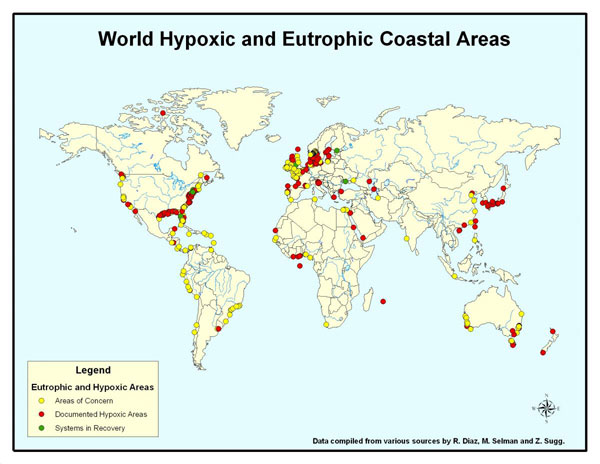400-Plus Coastal Zones Are Dying
Carbon Isn't the Only Global Cycle Out of Whack
The world is getting familiar with the carbon cycle and how pumping
carbon that's been buried for millions of years into the atmosphere
causes some global problems. Well, get ready to learn about nitrogen.
Like carbon, the nitrogen cycle is all out of
whack. In this case, the origins are similar. Instead of burning
petroleum or coal, nitrogen comes from natural gas transformed into
ammonia fertilizer and used to grow crops; what doesn't absorb into the
soil runs off into streams, which flow into rivers, which flow to the
ocean, where the nitrogen fuels "dead zones" – areas where nitrogen (and
phosphorus) fertilizes so much algae growth that it absorbs enough
oxygen to make the water inhospitable to fish and other marine life.
Jellyfish are about the only thing that thrives in these conditions;
corals certainly do not.
There are other causes of dead zones; human sewage, inadequately
treated, is another, as is the fallout from burning fossil fuels and
certain industrial processes. Dead zones, which start as "eutrophic"
zones (that is, over-rich with fertilizers), and end up as "hypoxic"
areas (that is, short of oxygen), often shrink and grow with the
seasons.
The World Resources Institute recently mapped the world's dead zones and
found a whopping 415 eutrophic zones, including 169 that are known to be
hypoxic and another 169 that probably are. The researchers believe the
number is much higher, since only the United States and the European
Union do an adequate job of counting and reporting problem coastal
areas. China and other fast-growing Asian economies are likely polluting
their coasts, but the problem hasn't been documented, the researchers
say.
world hypoxic and eutrophic zones

As the map shows, a mere 13 eutrophic zones are in recovery – a
particularly sorry tally considering scientists have long known the
causes and have long since identified solutions to the problem. The
Chesapeake Bay and Gulf of Mexico are two examples close to home of
systems whose dead zones are well documented, but not greatly improved,
even despite millions of taxpayer dollars being spent on the problem.
(The Gulf of Mexico dead zone threatened to grow bigger than ever in
2007, as farmers buoyed by ethanol subsidies planted a near-record crop
of corn, leading to a flood of fertilizer down the Mississippi.)
"Our findings highlight the dramatic growth of areas receiving the
endflows of nitrogen and phosphorus created by agriculture, increasing
industry, fossil fuel combustion, and population growth," Mindy Selman,
one of the researchers, wrote. "More than 1,000 scientists estimated, in
the Millennium Ecosystem Assessment, that, as a result of human
activities over the past 50 years, the flux of nitrogen has doubled over
natural values while the flux of phosphorus has tripled."
http://www.thedailygreen.com/environmental-news/latest/eutrophic-hypoxic47010708